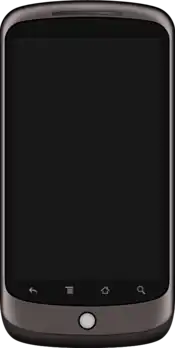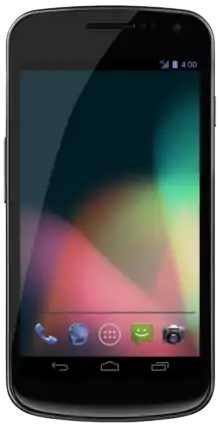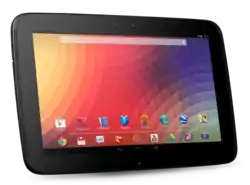| Developer | |
|---|---|
| Manufacturer | Google, various |
| Type | Smartphones, tablets, digital media players |
| Release date | January 5, 2010 |
| Lifespan | approximately 6 years |
| Operating system | Android |
| Online services | Google Play |
| Successor | Google Pixel |
Google Nexus is a discontinued line of consumer electronic devices that run the Android operating system. Google managed the design, development, marketing, and support of these devices, but some development and all manufacturing were carried out by partnering with original equipment manufacturers (OEMs). Alongside the main smartphone products, the line also included tablet computers and streaming media players; the Nexus started out in January 2010 and reached its end in October 2016,[1] replaced by Google Pixel.
Devices in the Nexus line[2] were considered Google's core Android products. They contained little to no manufacturer or wireless carrier modifications to Android (such as custom user interfaces[3]), although devices sold through carriers may be SIM locked, had some extra branding, and may have received software updates at a slower pace than the unlocked variant. Save for some carrier-specific variants, Nexus devices were often among the first Android devices to receive updates to the operating system.[4][5][6] All Nexus devices featured an unlockable bootloader[7] to allow further development and end-user modification. Although Nexus devices were originally produced in small quantities as they were intended as developer phones, the lack of bloatware/modifications to Android while providing similar performance to more expensive flagship smartphones from OEMs gained Nexus devices a considerable following.[8] In addition to the Nexus program, Google also sold Google Play editions of OEM devices, which run the "stock" version of Android without the OEM nor carrier modifications.[9]
OEMs that were part of the Nexus program were namely HTC, Samsung, LG, Motorola, Huawei and Asus. In late 2016, the Nexus lineup was replaced by the Google Pixel, which provides a similar stock Android experience but sold for considerably higher prices, directly competing with flagship smartphones from OEMs. Google stated that they "don't want to close a door completely, but there is no plan right now to do more Nexus devices."[10] In 2017, Google partnered with HMD Global in making new Nokia phones, as part of the Android One program, which has been considered by some as a spiritual successor to the Nexus.[11][12][13][14]
Devices
Phones
Nexus One

The Nexus One was manufactured by HTC and released in January 2010 as the first Nexus phone. It was released with Android 2.1 Eclair, and was updated in May 2010 to be the first phone with Android 2.2 Froyo. It was further updated to Android 2.3 Gingerbread. It was announced that Google would cease support for the Nexus One, whose graphics processing unit (GPU) is poor at rendering the new 2D acceleration engine of the UI in Android 4.0 Ice Cream Sandwich. The Nexus S and newer models have hardware designed to handle the new rendering. It was the only Nexus device to have card storage expandability (SD).
- Display: 3.7" display with 800×480 pixel resolution
- CPU: 1 GHz Qualcomm Scorpion
- Storage: 512 MB (expandable)
- RAM: 512 MB
- GPU: Adreno 200
- Camera: 5 MP rear camera
Nexus S

The Nexus S, manufactured by Samsung, was released in December 2010 to coincide with the release of Android 2.3 Gingerbread. In December 2011 it was updated to Android 4.0 Ice Cream Sandwich, with most variations later being updatable to Android 4.1 Jelly Bean in July 2012.[15] The device's support was ended after 4.1 Jelly Bean and no longer receives updates from Google.
- Display: 4.0" display with 800×480 pixel resolution
- Chipset: Hummingbird
- CPU: 1 GHz single-core ARM Cortex-A8
- Storage: 16 GB (Partitioned: 1 GB internal storage and 15 GB USB storage)
- RAM: 512 MB
- GPU: PowerVR SGX540
- Battery: 1500 mAH (replaceable)
Galaxy Nexus

The Galaxy Nexus, again manufactured by Samsung, was released in November 2011 (GSM version, US version released on December 15, 2011) to coincide with the release of Android 4.0 Ice Cream Sandwich. The device support was ended after 4.3 Jelly Bean and no longer receives updates from Google. This device is known in Brazil as Galaxy X due to a trademark on the "Nexus" brand.[16] It is also the last Nexus device to have a removable battery.
- Display: 4.65" HD Super AMOLED display with 1280×720 pixel resolution
- CPU: 1.2 GHz dual-core ARM Cortex A9
- Storage: 16 or 32 GB
- RAM: 1 GB
Nexus 4

The Nexus 4 smartphone, also known as the LG Nexus 4 or LG Mako, was released in November 2012 and manufactured by LG. It was the first Android device that used Android 4.2 Jelly Bean update version. Nexus 4 is the first Nexus device to have wireless charging capabilities. It was updated to Android 4.3 in June 2013 and to Android 4.4 in November 2013. It can run Android 5.1 as of April 2015.[17] The Nexus 4 has the following characteristics:
- Display: 4.7" Corning Gorilla Glass 2, True HD IPS Plus capacitive touchscreen, 768×1280 pixel resolution, 16M colors
- CPU: Quad-core 1.5 GHz Krait
- Chipset: Qualcomm Snapdragon APQ8064
- Storage: 8 or 16 GB
- RAM: 2 GB
- GPU: Adreno 320
- Battery: Non-removable Li-Po 2100 mAh battery, wireless charging
- Camera: 8 MP rear camera with 3264×2448 pixels, autofocus, and LED flash; 1.3 MP front camera
Nexus 5
.jpg.webp)
The Nexus 5 smartphone, again manufactured by LG, was scheduled for sale on October 31, 2013 for US$349 at the Google Play store. It was the first device to run Android 4.4 KitKat. The Nexus 5 did not receive an official Android 7.0 Nougat update,[18] meaning that Android 6.0.1 Marshmallow is the last officially supported Android version for the device. The Nexus 5 has the following characteristics:[19]
- Display: 4.95" Corning Gorilla Glass 3, IPS LCD touchscreen, 1080×1920 pixel resolution (1080p)
- Processor: 2.26 GHz Krait 400 quad-core processor on a Qualcomm Snapdragon 800 SoC
- Storage: 16 or 32 GB
- RAM: 2 GB
- GPU: Adreno 330
- Battery: 2,300 mAh lithium polymer, wireless charging
- Cameras: 8 MP rear camera with optical image stabilization (OIS); 1.3 MP front camera
- Connectivity: 4G LTE, 802.11 a/b/g/n/ac Wi-Fi, Bluetooth 4.0
- Colors: Black, White, or Red
Nexus 6

The Nexus 6 is a smartphone developed by Motorola, originally running Android 5.0 Lollipop (upgradeable to Android 7.1.1 Nougat[20]). It was first announced on October 15, 2014 along with the Nexus 9 and the Nexus Player.[21][22]
- Display: 5.96" Quad HD AMOLED PenTile (RGBG) display with 1440×2560 pixel resolution (493 ppi)
- Processor: Qualcomm Snapdragon 805 - Quad-core 2.7 GHz
- Modem: Qualcomm MDM9625M
- Storage: 32 or 64 GB
- RAM: 3 GB
- GPU: Adreno 420
- Battery: 3220 mAh with Turbo Charging technology, non-removable, wired charging
- Cameras: 13 MP rear camera with f/2.0 lens featuring OIS; 2 MP front camera
- Speakers: Dual front facing stereo
- Colors: Midnight Blue and Cloud White
Nexus 5X
.jpg.webp)
The Nexus 5X is a smartphone developed by LG originally running Android 6.0 Marshmallow (upgradeable to Android 8.1.0 Oreo[23]). It was first announced on September 29, 2015, along with the Nexus 6P and several other Google devices (such as the Pixel C tablet).[24]
- Display: 5.2" FHD LCD display with 1080×1920 pixel resolution (423ppi)
- Processor: Qualcomm Snapdragon 808 - Hexa-core 1.8 GHz
- Storage: 16 or 32 GB
- RAM: 2 GB LPDDR3
- GPU: Adreno 418
- Battery: 2700 mAh with rapid charging, non-removable
- Cameras: 12.3 MP rear camera with f/2.0 lens and IR laser-assisted autofocus;[25] 5 MP front camera with f/2.0 lens
- Speakers: Single front-facing speaker
- Colors: Carbon (black), Quartz (white), and Ice (mint)
Nexus 6P

The Nexus 6P is a smartphone developed by Huawei originally running Android 6.0 Marshmallow. It was first announced on September 29, 2015 along with the Nexus 5X and several other Google devices (such as the Pixel C tablet).[26]
- Display: 5.7" WQHD AMOLED display with 1440×2560 pixel resolution (518ppi)
- Processor: Qualcomm Snapdragon 810 - Octa-core 4 × 1.95 GHz, 4 × 1.55 GHz
- Storage: 32, 64, or 128 GB
- RAM: 3 GB LPDDR4
- GPU: Adreno 430
- Battery: 3450 mAh with rapid charging, non-removable
- Cameras: 12.3 MP rear camera with f/2.0 lens and IR laser-assisted autofocus;[25] 8 MP front camera with f/2.0 lens
- Speakers: Dual front-facing stereo
- Colors: Aluminum, Graphite, Frost, or Gold[27][28]
Tablets
Nexus 7
First generation
.png.webp)
On June 27, 2012, at its I/O 2012 keynote presentation, Google introduced the Nexus 7, a 7-inch tablet computer developed with and manufactured by Asus. Released in July 2012, it was the first device to run Android 4.1 Jelly Bean. The latest Android version supported by Google for the device is Android 5.1.1 Lollipop.
Second generation
.png.webp)
On July 24, 2013, at Google's "Breakfast with Sundar Pichai" press conference, Pichai introduced the second generation Nexus 7, again co-developed with Asus. Keeping with Google Nexus tradition, it was simultaneously released with the latest version, Android 4.3 Jelly Bean. It was made available on July 26, 2013 at select retailers and on the Google Play store in the United States.[29] On November 20, 2013, it was available from the Google Play stores in Hong Kong and India. On the same day, the Nexus Wireless Charger was made available in the United States and Canada.[30] In December 2015, Google released Android 6.0.1 Marshmallow for the device.[31] The Nexus 7 (2013) will not receive an official Android 7.0 Nougat update,[18] meaning that Android 6.0.1 Marshmallow is the last officially supported Android version for the tablet.
- Display: 7.02" display with 1920×1200 pixel resolution
- Chipset: Qualcomm Snapdragon S4Pro
- CPU: 1.51 GHz quad-core Krait 300
- Storage: 16 or 32 GB
- RAM: 2 GB
- GPU: 400 MHz quad-core Adreno 320
- Battery: 3950 mAh (non-removable)
Nexus 10

The Nexus 10, a 10.1-inch tablet manufactured by Samsung, was revealed in late October 2012 by the Exif data of photos taken by Google executive, Vic Gundotra,[32] along with the leaks of its manual and a comprehensive series of photos. The leaked photos revealed a design similar to the Samsung Galaxy Note 10.1, with a 10.1-inch 2560×1600 display, 16 or 32 GB of storage, Android 4.2, and a dual-core 1.7 GHz Exynos 5 processor. The Nexus 10 was expected to be unveiled officially during a Google press event on October 29, 2012, but the event was postponed due to Hurricane Sandy.[33][34] The Nexus 10 would not receive any official updates beyond Android 5.1.1.
- Display: 10.1" Corning Gorilla Glass 2 with 2560×1600 pixel resolution
- CPU: 1.7 GHz dual-core Cortex-A15
- Chipset: Samsung Exynos 5250
- Storage: 16 or 32 GB
- RAM: 2 GB
- GPU: Mali-T604 MP4
Nexus 9

The Nexus 9 is an 8.9-inch tablet running Android 5.0 Lollipop, developed in collaboration between Google and HTC. It was first announced on October 15, 2014 along with the Nexus 6 and the Nexus Player.[21]
Digital media players
Nexus Q
The Nexus Q is a discontinued digital media player that ran Android and integrated with Google Play, to sell at US$299 in the United States.
After complaints about a lack of features for the price, the Nexus Q was shelved indefinitely; Google said it needed time to make the product "even better".[35] The Nexus Q was unofficially replaced by the Chromecast, and further by the Nexus Player.
- Storage: 16 GB
- RAM: 1 GB
Nexus Player
The Nexus Player is a streaming media player created in collaboration between Google and Asus. It is the first device running Android TV. It was first announced on October 15, 2014 along with the Nexus 6 and the Nexus 9.[21] On May 24, 2016, Google discontinued sales of the Nexus Player.[36] In March 2018, Google confirmed that the Nexus Player would not receive the upcoming version of Android, Android Pie, and that security updates had also ended for the device.[37]
- 1.8 GHz quad-core Intel Atom processor
- 802.11ac 2x2 (MIMO)
- HDMI out
- Remote control (with 2 AAA batteries)
- Gamepad (Purchased separately)[38]
Philip K. Dick estate claim
Upon the announcement of the first Nexus device, the Nexus One, the estate of science fiction author Philip K. Dick claimed that the Nexus One name capitalized on intellectual property from Dick's 1968 novel Do Androids Dream of Electric Sheep? and that the choice of name was a direct reference to the Nexus-6 series of androids in the novel.[39]
See also
References
- ↑ "Google Kills Nexus Series, Removes All Products From Google Store". Gadgets 360. October 5, 2016. Retrieved January 2, 2023.
- ↑ Topolsky, Joshua (December 10, 2010). "Nexus S review". Engadget. AOL. Retrieved August 2, 2012.
- ↑ "The ultimate Android UI comparison: 2017 edition - AndroidPIT". June 11, 2017.
- ↑ Purdy, Kevin (December 6, 2010). "Google Launches Android 2.3 Gingerbread and Nexus S Flagship Phone". Lifehacker. Gawker Media. Retrieved November 22, 2011.
- ↑ Ho, Erica; Rose, Brent (October 18, 2011). "This Is the Samsung Galaxy Nexus, Google's New Official Android Phone". Gizmodo. Gawker Media. Retrieved November 22, 2011.
- ↑ Kendrick, James (October 27, 2011). "Don't Diss My Phone: Nexus S to Get Ice Cream Sandwich Within Weeks". ZDNet. CBS Interactive. Retrieved November 22, 2011.
- ↑ Bray, Tim (December 20, 2010). "It's not "rooting", it's openness" (blog). Android Developers. Google. Retrieved November 22, 2011.
- ↑ Volpe, Joseph (November 3, 2011). "Galaxy Nexus gets rooted, forums burst into applause". Engadget. AOL. Retrieved November 22, 2011.
- ↑ Bohn, Dieter (June 26, 2013). "Pure Android: Samsung Galaxy S4 and HTC One 'Google Play editions' review". The Verge. Vox Media. Retrieved August 4, 2014.
- ↑ Gurman, Mark (October 4, 2016). "This Man Is Explaining Google's Hardware Bet to Android Partners". Bloomberg L.P. Retrieved October 5, 2016.
- ↑ "Nokia phones are going to be similar to Google Nexus phones". Archived from the original on August 20, 2021.
- ↑ "Nokia Wants To Make Its Android Phones The New Nexus Phones". Archived from the original on June 22, 2017. Retrieved June 24, 2017.
- ↑ "Nokia to Recreate the Nexus Model". MazumaMobile.com. April 12, 2017. Archived from the original on August 21, 2017. Retrieved June 24, 2017.
- ↑ "Nokia-Google Partnership: HMD Global Ramps Up Efforts For Ambitious Android Campaign". April 18, 2017.
- ↑ Parsons, Chris (July 19, 2012). "Android 4.1.1 Jelly Bean OTA now appearing on some Nexus S variations". Android Central. Mobile Nations. Retrieved July 19, 2012.
- ↑ "Apresentando Galaxy X" (in Portuguese). Archived from the original on October 1, 2015. Retrieved September 23, 2012.
- ↑ "Google Posts Android 5.1 Factory Images For The Nexus 4, Nexus 7 2013, And Nexus 7 2013 LTE". April 14, 2015.
- 1 2 Ruddock, David (August 22, 2016). "RIP: The Nexus 5 isn't getting Android 7.0 Nougat, let's say our goodbyes". Android Police. Illogical Robot LLC. Retrieved August 24, 2016.
- ↑ "Nexus 5 round-up: 5 awesome new features, release date, price, specs and all we know so far". November 18, 2013.
- ↑ "Android 7.1.1 image and OTA files finally available for the Nexus 6". January 5, 2017.
- 1 2 3 "Android: Be together. Not the same". October 15, 2014.
- ↑ "Google Nexus". Nexus 6. October 15, 2014. Retrieved October 15, 2014.
- ↑ "Factory Images for Nexus and Pixel Devices | Google Play services". Google Developers. Retrieved September 30, 2021.
- ↑ "Nexus 6P". September 29, 2015. Retrieved September 29, 2015.
- 1 2 Zimmerman, Steven (October 12, 2016). "Sony IMX378: Comprehensive Breakdown of the Google Pixel's Sensor and its Features". XDA Developers. Retrieved October 17, 2016.
- ↑ "Nexus 6P - Elegantly designed, pure Android". Google. September 29, 2015. Retrieved August 21, 2017.
- ↑ Lardinois, Frederic (January 5, 2016). "Google and Huawei Bring Gold-Colored Nexus 6P To US". TechCrunch. Oath Tech Network. Retrieved March 18, 2018.
- ↑ P., Daniel (October 2015). "What are your favorite Nexus 5X and 6P chassis colors?". Phone Arena. phoneArena.com. Retrieved March 18, 2018.
- ↑ Stern, Joanna. "Google Nexus 7 Tablet, Chromecast Announced". ABC News. ABC News Internet Ventures. Retrieved July 29, 2013.
- ↑ "Nexus 5 and 7 available on Play Store for India and Hong Kong". androidaio.com. Archived from the original on November 23, 2013. Retrieved November 20, 2013.
- ↑ "Android 6.0.1 Marshmallow With New Emoji Available For Nexus 6P, Nexus 5X, Nexus 6, Nexus 5, Nexus 9, Nexus 7 (2013)". International Business Times. December 8, 2015.
- ↑ "Vic Gundotra - Google+ - Early morning walk on the beach".
- ↑ "Purported Samsung Nexus 10 tablet manual leaks online". CNET. Retrieved October 27, 2012.
- ↑ Olivarez-Giles, Nathan. "Nexus 10 Leaks Point to Better-Than-iPad Display". Wired. Retrieved October 27, 2012.
- ↑ "Google Suspends Launch Of Nexus Q, Promises Free Q To Those Who Pre-Ordered". July 31, 2012.
- ↑ "Google confirms the Nexus Player has been discontinued". May 24, 2016.
- ↑ Gao, Richard (March 23, 2018). "[Update: No more security updates either] Confirmed: The Nexus Player will not be updated to Android P". Android Police. Illogical Robot LLC.
- ↑ "Nexus Player". Google Nexus. Google Inc. October 15, 2014. Archived from the original on March 18, 2016. Retrieved October 15, 2014.
- ↑ "Nexus Name Irks Author's Estate". The Wall Street Journal. January 5, 2010.